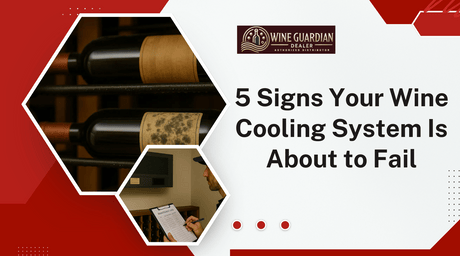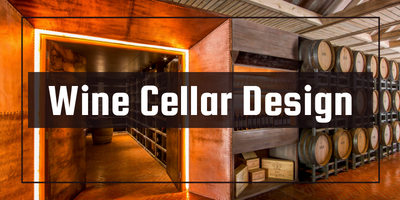
5 Signs Your Wine Cooling System Is About to Fail
Don’t wait for a costly surprise. Wine Guardian Dealer breaks down the top 5 signs your wine cooling system may be failing — and how to fix it before damage...
Jim Hopper
In Stock & Ready to Ship – Order Your Wine Cooling System Today!
Free Wine Cellar Expert Consultation | 📞 Call 1-800-260-1712
Start with a free expert consult—cooling system sizing, racking options, and no upsells.

Build your dream wine cellar—without costly mistakes or guesswork.
By Jim Hopper, Wine Cooling Expert
If you're serious about your wine collection, investing in the best wine cellar cooling unit is non-negotiable. Without proper temperature and humidity control, your wines could age too quickly, lose their flavor, or even spoil.
That’s why Wine Guardian is a top-rated brand among wine collectors and professionals. Known for their high-performance, energy-efficient, and reliable cooling solutions, Wine Guardian offers ducted cooling systems, ductless split units, and through-the-wall wine cooling units to suit any cellar size or design. Learn how each option compares in our full Wine Cooling System Comparisons: Find the Best Fit.

Wine cellar cooling systems are essential for maintaining the perfect environment for your wine collection. These systems are specifically designed to regulate both temperature and humidity within a wine cellar or wine room, ensuring that your wines age gracefully and retain their quality over time. Unlike standard air conditioning units, wine cellar cooling systems are tailored to meet the unique needs of wine storage.
A typical wine cellar cooling system comprises a refrigeration unit, a humidifier, and a control system. The refrigeration unit keeps the temperature within the ideal range, while the humidifier ensures that the humidity levels are optimal for preserving the corks and preventing mold growth. The control system allows you to monitor and adjust these settings, providing precise control over your wine cellar’s environment.
By investing in a high-quality wine cellar cooling system, you can protect your wine collection from the adverse effects of temperature fluctuations and improper humidity levels. Whether you have a small wine room or a large wine cellar, there are various cooling systems available, including self-contained cooling units, split cooling systems, and ducted cooling systems, to suit your specific needs.
✅ Why Wine Guardian cooling units are the best for wine cellars
✅ A breakdown of Wine Guardian’s best-selling models, including the top-rated D025
✅ How to choose the perfect cooling system for your wine cellar
✅ Installation and maintenance tips to maximize the lifespan of your unit
Now, let’s dive in! 🍷

Unlike traditional air conditioners, which can fluctuate in temperature and remove humidity, wine cooling units are specifically designed for wine preservation.
|
Feature |
Benefit |
|---|---|
|
Precise Temperature & Humidity Control |
Maintains a stable range between 50–64°F (10–18°C) and optimal humidity to protect corks and prevent mold |
|
Eco-Friendly & Energy-Efficient |
Uses environmentally friendly refrigerants and operates on low energy consumption |
|
Advanced Filtration & Ventilation |
Prevents mold, mildew, and airborne contaminants from affecting your wine |
|
Flexible Installation Options |
Choose between ducted, ductless split, or through-the-wall units to match any cellar design |
|
Whisper-Quiet Operation |
Perfect for wine tasting rooms and home cellars where noise levels matter |
Choosing the right type of cooling system depends on your cellar size, budget, and aesthetic preferences. Here’s a quick overview:
|
System Type |
Best For |
Key Benefits |
|---|---|---|
|
Large wine cellars & high-end setups |
Silent operation, hidden installation, even air distribution |
|
|
Ductless Split Systems |
Homes & retrofit installations |
Quiet, flexible placement, efficient cooling |
|
Through-the-Wall Units |
Small wine cellars & DIY projects |
Easy installation, cost-effective, compact design. Often positioned on an exterior wall to facilitate proper ventilation by exhausting warm air outside. |
Now, let’s explore the best-selling Wine Guardian cooling units and why they are the top choice for wine collectors.

Wine Guardian offers several highly rated cooling units, but some models stand out due to their popularity, performance, and customer satisfaction.
✅ Ideal for: Small-to-medium wine cellars (up to 1,200 cubic feet)
✅ Best for: Seamless cooling, quiet operation, and energy efficiency
The Wine Guardian D025 is the best-selling ducted wine cellar cooling system. It is designed for discreet installation, ensuring a consistent climate without any visible cooling unit inside your wine room.
✔ Whisper-quiet operation – Perfect for home wine cellars and tasting rooms
✔ Ducted design – Concealed installation with even air distribution
✔ Built-in humidity control – Prevents cork shrinkage and label damage
✔ Energy-efficient system – Reduces electricity costs while maintaining stable conditions
Ducted systems like the Wine Guardian D025 are perfect for wine enthusiasts who prioritize aesthetics and silent operation . Since the cooling unit is installed remotely, all you see in your wine room is perfectly chilled wine—no bulky equipment in sight! Ducted systems can be installed outside the cellar, preserving the quiet ambiance and are also ideal for long-term wine storage as they maintain consistent temperature and humidity levels, crucial for preserving wine quality over time.
💡 Pro Tip: If you have a larger wine cellar, consider these other best-selling ducted models:
|
Model |
Cellar Capacity |
|---|---|
|
D050 |
Up to 2,200 cubic feet |
|
D088 |
Up to 3,000 cubic feet |
✅ Ideal for: Small-to-medium wine cellars (up to 1,200 cubic feet)
✅ Best for: Flexible installation and quiet operation
If you don’t want to install ducts, the Wine Guardian SS018 split system offers powerful cooling while keeping the condenser unit outside the wine room. Ductless split cooling units offer options for small to medium-sized spaces without ductwork requirements, making them versatile and efficient for various cellar designs.
✔ Compact evaporator unit – Saves space inside the wine room
✔ Remote condenser placement – Reduces noise and heat inside the cellar
✔ Ideal for retrofit applications – No need for ductwork
💡 Pro Tip: If you have a larger custom wine cellar, check out the SS088 split system for bigger spaces.
✅ Ideal for: Small wine cellars (up to 500 cubic feet) ✅ Best for: DIY installation and cost-effectiveness
The Wine Guardian TTW018 is the top-rated through-the-wall wine cooling system, making it perfect for home collectors who want a simple and budget-friendly cooling solution. Through-the-wall wine cellar cooling units are self-contained cooling systems that exhaust warm air outside, ensuring proper preservation conditions by providing both cooling and heating options.
✔ Easy installation – Perfect for DIY wine cellar projects
✔ Affordable cooling solution – Great for small wine rooms
✔ Energy-efficient – Helps lower electricity costs
✔ Digital thermostat – Provides precise temperature control for optimal wine storage
Selecting the right wine cooling unit is essential for preserving your collection. Consider the following factors:
|
Factor |
What to Consider |
|---|---|
|
Cellar Size |
Match the unit to the cubic footage of your cellar |
|
Installation Type |
Ducted for hidden cooling, split for flexibility, through-the-wall for DIY setups |
|
Noise Sensitivity |
Ducted & split systems offer the quietest operation |
|
Future Expansion |
If your collection is growing, consider a higher-capacity unit |

To extend the lifespan of your wine cooling system, follow these best practices:
✅ Hire a professional installer to set up and calibrate your unit correctly ✅ Clean or replace air filters every few months to maintain airflow ✅ Inspect refrigerant lines regularly to prevent leaks ✅ Schedule annual maintenance to ensure peak performance
Specialized cooling solutions are also available for wine cabinets, which regulate temperature and humidity within these storage units to maintain optimal conditions for aging and preserving wine quality. Cabinet cooling systems are designed specifically for wine cabinets and do not require ductwork or a drain line, making them a convenient option for compact spaces.
💡 Bonus Tip: Install a vapor barrier in your wine cellar to prevent excess moisture infiltration, which can affect humidity control.
Maintaining the ideal temperature and humidity levels is crucial for the proper storage and aging of wine. Generally, the optimal temperature range for wine storage is between 45°F and 65°F (7°C and 18°C), with the sweet spot being around 55°F to 57°F (12°C to 14°C). This temperature range helps to slow down the aging process, allowing the wine to develop its flavors and aromas over time.
Humidity control is equally important. The ideal humidity level for wine storage is around 60% relative humidity, with levels up to 80% being acceptable. Proper humidity levels prevent the corks from drying out, which can lead to air entering the bottle and spoiling the wine. Conversely, high humidity levels can cause mold and mildew growth, damaging labels and potentially affecting the wine’s quality.
Wine cellar cooling systems are designed to provide precise temperature and humidity control, ensuring that your wine collection is stored under optimal conditions. These systems come in various configurations, such as self-contained cooling units, split cooling systems, and ducted cooling systems, each offering different benefits depending on your wine cellar’s size and design.
When choosing a wine cellar cooling system, consider factors such as the size of your wine cellar, the types of wine you are storing, and your desired temperature and humidity levels. A professional-grade cooling system will help you create the perfect environment for your fine wines, ensuring they age gracefully and maintain their exceptional quality and flavor.
When it comes to wine preservation, Wine Guardian’s top-rated cooling units deliver industry-leading temperature and humidity control to protect your collection for years to come.
Explore Wine Guardian’s full range of cooling systems, including the best-selling D025, today!
Wine cooling systems offer precise temperature and humidity control, while standard ACs fluctuate and dry out the air — risking oxidation and spoilage.
The TTW018 is ideal for small wine rooms (up to 500 cu. ft.). It’s energy-efficient, compact, and great for DIY installation.
Ducted systems like the Wine Guardian D025 or D050 provide near-silent operation since the cooling unit is installed remotely.
Match the unit to your cellar’s cubic footage. Also consider insulation, ceiling height, and future wine collection growth.
Clean filters every few months and schedule annual maintenance. Check refrigerant lines and monitor humidity regularly.
🛒Shop our most-loved Wine Guardian cooling systems today.
🛠️Protect your wine with the most trusted systems on the market.
❤️Tested, reviewed, and loved by serious collectors like you.